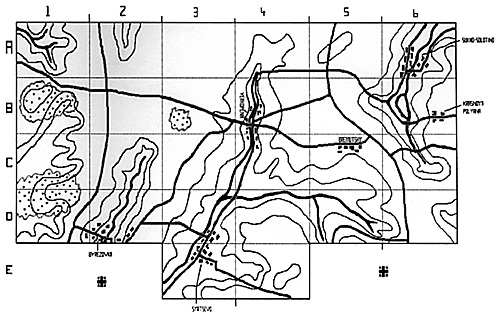The Last Square Store, situated in Madison, Wisconsin, hosted an Invitational gaming weekend on February 7, 1998. This gaming weekend provided an opportunity for the historical gamer to participate in a historical miniatures game of truly epic proportions, the Battle of Kursk.
The Eastern Front was the largest military conflict in history. The military situation in the spring of 1943 centered on the Kursk salient. The bulge dominated the attention of both the German General Staff and the Soviet High Command. The Russians viewed the salient as a possible springboard for their summer offensive against Army Group South. The German saw the salient as an opportunity to launch a classic pincer attack which would destroy significant Russian formations. Thus the die was cast for the coming engagement.
The battle of Kursk was fought in the summer of 1943 and proved to be the largest tank battle of all time. The field chosen for the game was a portion of the Southern pincers(the Voronezh front) of the Battle of Kursk. The arena occupied by the XLVIII Panzer Corps will be our focus. The miniature terrain has been faithfully recreated from maps obtained from the University of Wisconsin and the University of Kansas. The game field covered an area 24 ft by 10 ft with another 2.5 ft extension in the center. A map of the game field is pictured below.
GAME RULES
The players used Arty Conliffe's Spearhead Rules to run the game. The scenario required several minor changes to the rules as published. The changes were:
1. To simulate the teething problems with the new panther tanks, the German player upon wanting to move a panther model was required to roll on a d6. The possibility that the vehicle would suffer mechanical problems was 50%. If this happened, the unit could not move but could fire unless a 1 was rolled, then the unit was suppressed. The process would be repeated each turn movement was attempted. Suppression was not rolled off as normal suppression, but would be removed if the player die roll resulted in a allowed movement.
2. To simulate the effect of the political Commissar on the Russian formations, we developed a Commissar rule. Each Russian Corps was given a figure tagged as the Commissar and the player could move the figure to where it could provide the maximum benefit. The figure could be eliminated as an FO could be eliminated. The rule provided a positive modifier in close combat, order changes and morale.
3. Minor changes in movement in terrain situations. eg. Vehicles entering streams or rivers were required to roll a d6 to determine if they mired down in the mud.
4. Morale was changed in that a unit was removed from play if a 1-2 was rolled on a d6, the unit moved a triple move to the rear if a 3-4 was rolled on a d6, and the unit continued if a 5-6 was rolled.
5. Artillery response for the Russians was changed to reflect that their observers at the start of the battle were already linked to the artillery/mortar formations. If the observer moved then the response reverted to the table as published in the rules.
6. Special rules were designed to manage the air combat.
Credits:
The miniatures were provided by Mark Anderson, Ted Alecos, John Brzezinski, Peter Elmer, Kevin Manhart, John Shephard, Nate Reed, and Jon Von Houten. Special mention should be made of the modeling accomplishments of John Brzezinski which provided aircraft and special figures not available from commercial sources.
The terrain layout was designed by John Shephard and Mark Anderson.
The pictures are courtesy of Jim Meldrum.
More Kursk 1943
-
Kursk 1943: Introduction
Kursk 1943: Russian and German Forces
Kursk 1943: Turns 1-8
Kursk 1943: Turns 9-16
Kursk 1943: Turns 17-end
Kursk 1943: Conclusion

Back to War Lore: The List
Back to Master Magazine List
© Copyright 1998 by Coalition Web, Inc.
This article appears in MagWeb (Magazine Web) on the Internet World Wide Web.
Other military history articles and gaming articles are available at http://www.magweb.com